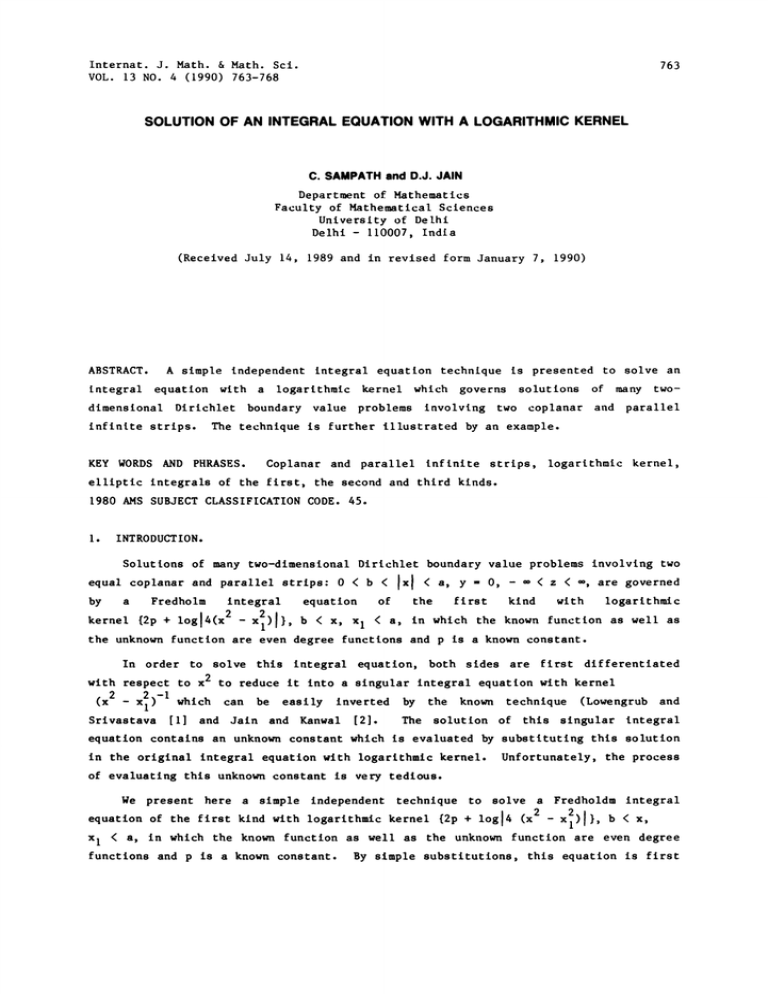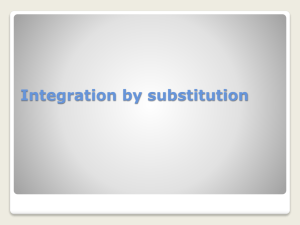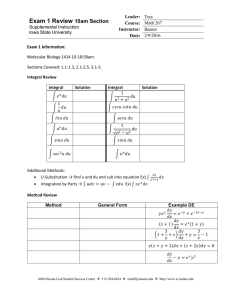Document 10439301
advertisement

Internat. J. Math. & Math. Sci.
VOL. 13 NO. 4 (1990) 763-768
763
SOLUTION OF AN INTEGRAL EQUATION WITH A LOGARITHMIC KERNEL
C. SAMPATH and D.J. JAIN
Department of Mathematics
Faculty of Mathematical Sciences
Unlverslty of Delhi
Delhi- 110007, India
(Received July 14, 1989 and in revised form January 7, 1990)
A simple independent integral equation technique is presented to solve an
ABSTRACT.
Integral
equation
with
Dirlchlet
dimensional
infinite strips.
a
kernel which governs
logarithmic
of
solutions
involving two coplanar
boundary value problems
many
and
two-
parallel
The technique is further illustrated by an example.
KEY WORDS AND PHRASES.
logarithmic kernel,
Coplanar and parallel infinite strips,
elliptic integrals of the first, the second and third kinds.
1980 AMS SUBJECT CLASSIFICATION CODE. 45.
I.
INTRODUCTION.
Solutions of many two-dlmenslonal Dirlchlet boundary value problems involving two
equal coplanar and parallel strips: 0
by
a
Fredholm
kernel {2p +
logl4(x
,x)l}
integral
2
<
b
<
x, x
Ixl
<
b
of
equation
<
<
<
O,
a, y
the
first
kind
z
<
% are governed
with
logarithmic
a, in which the known function as well as
the unknown function are even degree functions and p is a known constant.
In order to solve this integral equation, both sides are first differentiated
with respect to x 2 to reduce it into a singular integral equation with kernel
(x
2
x)-I- which
Srivastava
can
be
easily
Inverted
[I] and Jain and Kanwal [2].
by
The
the
known technique
solution of
this
(Lowengrub and
singular Integral
equation contains an unknown constant which is evaluated by substituting this solution
in the original integral equation wlth logarithmic kernel.
Unfortunately, the process
of evaluating this unknown constant is very tedious.
We present here a simple independent technique to solve a Fredholdm integral
2
2
b < x,
{x
equation of the first kind with logarithmic kernel {2p +
log14
<
Xl)l}
a, in which the known function as well as the unknown function are even degree
functions and p is a known constant. By simple substitutions, this equation is first
x
764
C. SAMPATH AND D.L. JAIN
Fredholm integral equation of
transformed
into
kernel {2q +
logl2(cosS
a
cOS0L)l},
0
<
S,
<
I
the
first kind with logarithmic
where
q
known
a
is
constant.
Finally using the Fourier series expansions of the known functlon of this integral
equation and its kernel, the constant coefficients in the Fourier series expansion of
its unknown function are readily obtained by appealing to the orthogonal property
over the interval [0,].
cosines of the multiples of angle
o
Thus we have obtained
the Fourier series expansion of the unknown function of this integral equation which
readily yields
the
required
solution of
the given Fredholm integral equation by
We also explain here that this series
appeallng to the substitutions already used.
solution of the given integral equation can be reduced to the closed form obtained by
[L,2].
the known methods
,-
Finally we illustrate the application of our technique to
solve the Fredholm integral equation of the first kind with logarithmic kernel
{2p+logl4)(x 2
x)l}
2.
b
<
x, x
<
a, p being a known constant when the known even
Ixl.
degree function is
INTEGRAL EQUATION TECHNIQUE.
Solutions of many two-dlmenslon Dirlchlet boundary value problems involving two
equal coplanar and parallel strips: 0
<
b
<
Ixl
<
<
0,
a, y
z
<
, Is governed
by an Integral equation of the form
-b
a
-a
b
(2.1)
2)-
where f(x
is a known even degree function, p is a constant and
g(x 2
is an unknown
even degree functlon.
When we substitute in the integral equation (2.1)
it takes a simpler form
a
2 2
dx
(2p+lgl4(x-xl>l}
S Xl*CX
b
2
-" fCx >,
b
<
x
<
a.
In order to solve this integral equation by the known method
differentiate its both sides with respect to x
a x
l@(x)dx
S 2
bx
where
the
-x
2
w
f,(x2),
singular integral
is
2
<
x
<
a,
Cauchy principal value.
integral equation is known to be [1,2]
[1,2], we first
and get,
b
a
(2.3)
(2.4)
The solution of
this
SOLUTION OF AN INTEGRAL EQUATION WITH A LOGARITHMIC KERNAL
x
---(
(x
2
b
2
a
x
2
2
.)1/2
2
a
a
b
(2
x
2
2
xf’(x )dx +
2)
b
x
C
2
2
765
Xl
[(a
2
b
(x 2
2
xl
2
b )]
/2
< x! <
a,
(2.5)
where the constant C is to be evaluated by puttlng this value of
process of
of
evaluation
2
(x 1)
in (2.3).
This
very tedious as clearly shown In the
the constant C Is
illustrated example given at the end.
We present here a simple independent method of solving the integral equation
(2.3) without dlfferenttatlng its both sides.
First in (2.3) we make the
substitutions
x
2
Acos01
+ B,
(2.6)
x
2
Acos0 + B,
whe re
a
A
0
<
0,
0[ <
2
b
2
B
2
<
a when b
<
x, x
f h(01) {2q+logl2(cos0
0
a
2
+ b2
(2.7)
"--------,
a, and get
-cos01)l} d01 -F(0),
0
<
0
<
t
where
h(0 I)
sins
(2.9)
(x ),
p+log(a2-b 2) I/2.
q
f(x2).
F(0)
Now the Fourier series expansion of the known function F(0)
"
co +
F(0)
where
C
n
[
c
cosn0,
0
<
0
n-I
<
.
(2.12)
F(O) cosn0 dO
0
f
f(x
2)
n
roan0 dO,
0,1,2,...
0
are known coefficients and the formula
togl2(o,0 co,O)
cos nO cosnO
-2
1
n-I
lead the integral equation (2.8) to the form
n
0
<
0,
01 <
,
(2.13)
766
w
f
0
where
-
C. SAMPATH AND D.L. JAIN
do
function h(e
dn
cos n0
=
C
+
O
the
used
have
we
l):
h(0
I)
.
+
=-
d
+
o
.
nffil
I}
{2q-
ne
cos
"
2n__l
CnCosnO,
<
0
<
O
0
dncoSnOl,
series
of
expansion
unknown
the
.
01 <
<
(2.14)
7,
Fourier
following
ne
cos
n
(2.15)
0,I,2,... in this expansion are
the constant coefficients d n, n
readily obtained from equation (2.14) in terms of the known coefficients C n, n
The values
of
0,I,2,... by appealing to the orthogonal property of Cosines of the multiples of
e over the interval 0 < e < 7. These values are
angle
C
d
___o_
d
2wq
o
n
ffi-(nCn)/
(2.16)
n
where the values of the known coefficients Cn are given in relations (2.12). Lastly,
using the relations (2.9), (2.15) and (2.16) we obtain the required value of the
unknown function
@(x)
@(x
of the integral equation (2.3) in the form
2
2
where the relatlon between
cose
"
{Col(4q)
,2_b2
[(a -x l)(x
and
x
is
nC
n=l
n
cosne
(2.17)
given in the substitutions (2.6) and we
have used the following formulas readily derived from this relation:
e
x
2
b
2
e
a
2
x
2
i/2
(2 18)
We now explain that the series solution (2.17) of the unknown function
be put in the closed form (2.5) which is derived by the known technique
contains an unknown constant C.
n
can
When we integrate by parts, we obtain the integrals
which define the values of the C n in relations
C
@(x21
[1,2] and
A " slnne.slne.f’(x2)de,
=--f
n
0
n
(2.12), as
(2.19)
> I,
where we have used the relation between x 2 and Cose defined in the substitutions
(2.6).
Substitution
of
these values of the coefficients
Cn,
n
>
in the
solution (2.17), gives
(x21
2
,
f(x2)de +ATf (l_cose)f,(x2)de
0
series
SOLUTION OF AN INTEGRAL EQUATION WITH A LOGARITHMIC KERNAL
+ A
(l+cs01
tan
sin0.
0
f’(x2)d0
(cos0
cos0
I)
}’ b
<
x
<
767
(2,20)
a,
where we have used the relation
sin0
slnn0 cosn0
2-
(cos0-cos0)
l+cSOl
+ ,,:,;d-<7<;
d)
stnO
"T4c-7;-d"
readily derived from the
to 0.
formula (2.13)
<
0
O[ <
O,
(2.2i)
7,
by differenttatlng both sides with respect
Finally, when we use the substitutions (2.6), relations (2.7) and (2.18) in the
expression (2.20), we obtain
a
(a
2
-x
+
!
+
(x-b2j
2
x[(x2)dx
a
2
)1/2 (xf’ (x 2))dx
a_-x
(x2-b 2 )1/2(xfx- x))dx2 }’
b
< Xl <
b
(2.22)
a
which agrees with the known result (2.5), and the value of the unknown constant C in
the known result (2.5) is thus also evaluated by our technique and its value is
C
,2 {-
a
2)dx
[(a2_x2)(x2_b2)]
xf(x
a
+
2
2
xf’(x2) dx}
x-_"
(2.23)
This appears to be a new result.
3.
N ILLUSTRATIVE EXAMPLE.
To illustrate our technique, we solve the integral equation (2.3) when
so in this case
f(x)
Cx, f’(x) =---=-_, f’( x 2
_.
[2] is obtained by using the formula
Solution of this equation by the known technique
(2.5) and in this case, e have
@(x)
x21-b2
a -x
0
-
sln
w
(sln 2
(3.1)
2/x 2
2/x
01
2 0
sin
20 1/2
5) [l-K2sln
20
[(a 2
x
C
2
i)
(x
2
b
2
1/2
768
C. SAMPATH AND D.L. JAIN
2
2
x -b
r a 2_b2
=-!-)/2[na
(g’ 2 2’
(-f-a- x
a -x
+
C
i/2,
2
2
[( a -x. )(x.2_b2
< Xl <
b
c2)l/2
(-
2
F(,
(1-c)
1/2)]
(3.2)
a,
where we have used the substltut[ons (2.6), the relati’ons (2.18), and is the elllpt[c
integral of the third kind
8
n(,n2,K)
K
2
l-c
da
f0 (l-n2sin2a)(l-K2sln
2 V/2
a)
b/a, and F(,K)
c
(3.3)
is the elliptic integral of the first kind.
?
(x)
of the integral equation (2.3) given by the equation
(3.2) still contains the unknown constant C which is finally evaluated by substituting
this value of
in the integral equation (2.3) and evaluating some complicated
this case the solution
(x)
definite integrals.
-
The required value of C, in this case, is given by [2]
. [(I
a
c
E(,K)
where
.
E(,
I)
X) + F( ,K)],
(3.4)
is the elliptic integral of the second kind.
By substituting the above value of the constant C in the equation (3.2), we
obtain
the required solution of the integral equation (2.3), in this case,
known technique [1,2].
by our
technique,
by the
We readily obtain the solution of the integral equation (2.3)
in
case,
this
by putting the values of
f(x2),
f’(x
2)
from the
relations (3.1) in the formula (2.22) and this is given by
(x21)
+
2a
2
2a
2
Z
2
2
)]
(,
a
[a-Xl)(Xl-b
(x2
b
2)
Ill
]2
2
2
b
a -x
{ E(-,K)
2
2
,K)
+
F(,K)]},
F(,K)E(,K)
b
<
x
<
a.
(3.5)
This agrees with the solution given by the equations (3.2) and (3.4) which was derived
by the known technique [1,2].
REFERENCES
I.
LOWENGRUB, M. and SRIVASTAVA, K.N., Research Note on Two Coplanar Griffith
Cracks in an Infinite Elastic Medium, Int. J. Engng. Scl. 6 (1968), 359-262.
2.
JAIN, D.L.
and KANWAL, R.P., Acoustic Diffraction of a Plane Wave by Two
Coplanar Parallel Perfectly Soft or Rigid Strips Can. J. Phys. 50 (1972),
929-939.




